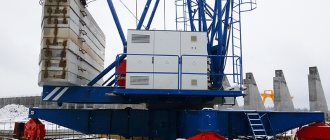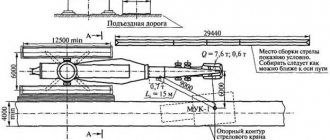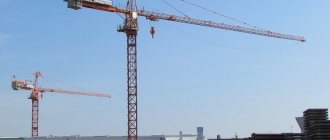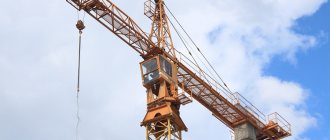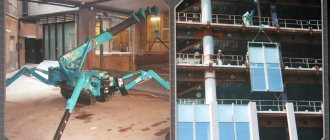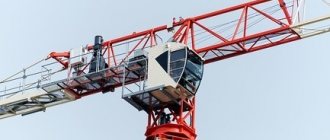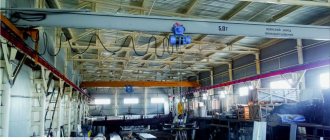Do-it-yourself lifting onto a tower crane
As far as I know, my friend works at an altitude of 60-70 meters, I can’t say more precisely, since I didn’t focus on this. But what I know for sure is that he independently rises to such a height along the internal stairs of the crane and the only protection against him falling down is the walls of the structure itself.
To be honest, I always used to think that the crane had some kind of elevator or hoist for the crane operator. It turns out I was wrong and 90% of all high-rise cranes do not have such lifts, since it is expensive and not very convenient. I won’t go into details about this option, if you’re interested, google it and you’ll find answers to this question, why they don’t install elevators.
So, since you have to work at height for an extremely long time and going down happens once per shift for a lunch break, and sometimes it doesn’t happen, since the cost of renting a crane is extremely high and many people work without long breaks for lunch or have lunch at the top. In this regard, a friend of mine drags with him to the top a backpack with food and all the essentials for life. Sometimes the weight of such luggage reaches up to 20 kg.
Where do crane operators go to the toilet when working at the top?
As my crane operator friend says, he has a quite large and comfortable cabin, which even has a wardrobe and a table with a kettle. But there are no toilet stalls or dry closets. This raises the main question, what to do if you get very impatient while working, where to run? My friend calmly answered this question,
that for emergencies he has a large 2-liter plastic bottle and a good, tight ziplock bag. In general, you now understand everything yourself. Old time-tested methods work.))
To be honest, I probably would have needed the bag halfway to the cabin.)) I’m not very good with heights and even feel a sense of discomfort when I come to my friends on the 16th floor, I’m no longer at ease. And here, working at a height of 70 meters, when you periodically sway, is such a pleasure. What do you say, would you become a crane operator?
What does a crane operator do?
The crane operator is located in a special cabin and operates the equipment to perform lifting and transport operations. He most often has to do his work while at a considerable height (from 20 to 200 meters). This does not apply to truck crane operators whose cabin is located on a turntable.
The crane operator always works in a team with slingers. While in his cabin, he must accurately understand the workers' signals. The speed of completing assigned tasks, as well as the life and health of people, largely depends on the correct or incorrect actions of the crane operator. Therefore, his work is very intense and requires smooth interaction with the team.
My work: what nightmares torment crane operators and why do they need a horizontal bar in the cabin?
We talk about the profession “Tower Crane Operator”.
Our heroine, Izhevsk resident Anastasia Zmeeva, has been working at a construction site for two years as a crane operator and can lift a 7-ton load “with just her left hand.” Their team builds houses and shopping centers. Now a high-rise building is being built at the intersection of Klubnaya and Dragunov streets. There are only a few girls in the profession.
During strong winds, the crane swings with an amplitude of a meter!
Previously, Nastya worked as a saleswoman. The salary was small, the position was financially responsible, and the craving for heights never left me.
“I took courses at the school,” says Nastya. — First, I trained to be a gantry and bridge crane operator (their height is approximately 30 m), then to become a tower crane operator (the average height is 50-60 m).
Anyone can get a qualification as a crane operator. For example, courses at the training center at Spetsstroy of Russia last 2 months. Training costs 12 thousand rubles. But not everyone will be allowed to work. Selection like astronauts!
“During the medical examination, they check the vestibular apparatus - they spin on a chair for several minutes, then you need to stand up and walk in a straight line without staggering,” shares the crane operator. - I left the race - they won’t let me work on the high crane. Vision must be excellent, but it is also possible with lenses. And, of course, the future crane operator should not be afraid of heights.
Now builders are already accustomed to the crane operator.
“At first, the Uzbek workers took pictures of me all the time,” Nastya recalls. “I was still a blonde then, on a 100-ton crane - a novelty for them.
Medical examination for crane operators, like astronauts! You need a good vestibular system and excellent vision.
The crane operator spends all day in the cab of the machine. Typically a shift lasts 8 hours with a lunch break. But when there is a lot of work, you have to stay up until night. Our second hero tells the story.
The crane operator climbs into the cabin twice: in the morning and in the afternoon. The whole way is along the usual stairs. No elevators or insurance!
“My cabin is located at an altitude of 70 meters - at the level of the 19th floor,” explains Nastya. The first days I climbed for half an hour. But now I’ve gotten used to it. I come to work, turn on music in my headphones, and climb upstairs in one song. I'll be down in two minutes. The builders and I once had a bet on whether I would finish it in that time or not.
To ensure a successful day, Alexander has a tradition.
— I always say hello to the crane. I say: “Hello, dear, how did you sleep?” shares the crane operator. “This crane is like family to me: I received a diploma, came here to work, and then it was just brought from the factory.
What a cabin should look like according to GOST
The internal height of the cabin is at least 1.8 meters, and its desired minimum length and width are 2 meters and 1.1 meters, respectively.
It is important that the dimensions are kept to a minimum. But it is also important to take into account that a worker will get tired faster from a cramped room, so he needs space so that he can periodically straighten up and relax his muscles.
The area of the cabin should provide easy access to equipment and allow both the crane operator and one more person (this could be a mechanic or a trainee) to be in it.
Exterior view of the overhead crane cabin. Manufacturer: Podemtransmash LLC
The location of the cabin in the crane must be such that, sitting in a chair, the crane operator can monitor the load and the hook suspension throughout the entire operation of the crane. It is important that the viewing angles, counting from the planes drawn from eye level, are from horizontal to the top - 60 degrees, to the bottom - 90 degrees; from vertical – 135 degrees in both directions.
Open-type cabins must have continuous fencing on all sides with a height of at least 1 meter. The fence can be made of durable transparent material (say, stalinite), which is well resistant to mechanical shock. When glazing closed cabins with safety glass in the viewing direction, it is important to take into account one standard glass size.
The location and number of transoms that are held in open or closed positions must make it possible to wipe the glass surfaces from the outside of the cabin. Glazing of crane cabins that operate outdoors requires sun shields. Those cabins that are suspended from trolleys must have mirrors for viewing the background. The lower windows on which the crane operator stands must be protected by bars.
The door to the cabin is made sliding or hinged, and the second one should open into the cabin. The size of the doorway must be at least 1.8 by 0.5 meters and must be sealed (to prevent moisture and dust).
Placed under the bridge gallery, the cabin must communicate with the stairs. In a cart-mounted cabin, entry is permitted through the outer stair railing or cart deck. The floor in the cabin is made in the form of a wooden flooring or other metal flooring, covered with a rubber mat.
The size of the mat must be at least 0.5 by 0.7 meters. They should be installed exclusively in areas where electrical equipment is serviced. The internal cladding of the walls is made of easily washable light materials. The cabin is illuminated using a lamp with a matte shade, which eliminates glare on the glass.
Construction of the overhead crane cabin
The panoramic cabin has the shape of an octagonal pyramid or a truncated cone; the cabin is suspended from the bridge by lugs that are attached to its upper belt. A platform with a remote control chair on it rests through the rollers on the lower belt. The platform (or in some cases the chair) is rotated 90 degrees in both directions by the crane operator by pushing his arm or leg away from the cabin railing. The platform is fixed every 30 degrees by a pedal drive. The current to the remote control is supplied through a flexible cable, which is located under the bottom of the cabin. The entrance is located on the side or top.
Fell in love immediately
“At the age of 18, I graduated from Belgorod vocational school No. 17, the training took a year, then I immediately came to work on a tower crane. Since then, I haven’t changed my profession for 33 years. Before Belgorod, I lived in Volgograd and never wondered how people build such large houses. Only after becoming a crane operator did I understand. I didn’t have any love for heights and tower cranes in particular, I just enrolled and started studying.
Two days after my 18th birthday, I already registered for a job. My first construction project was the new BelSU. At first they planned to build a building there, but in the 1990s they changed everything and began to build a university. The first construction was the most memorable. There were deep basements there, three floors deep, and I filled them with a grab (a double-jawed bucket - editor's note). Once I was digging sand on a jib crane and caught a pile. What a jerk! The grab broke free, the pile remained in place, and I flew off the seat.
I really liked the team and the profession, I loved my job. And three years later I was given an apartment in Maiskoye. If I could turn back time now, I would go back to studying to become a tower crane operator. You are responsible for everyone who is there under you. You need to place weights in certain places, for this you need good eyesight and hearing. It's hard. We only got walkie-talkies two years ago; before that, “myna” and “vira” were shouting.”
History of the profession
People have always needed mechanical devices for moving goods. But during the construction of ancient structures, manually driven cranes were used, and as such there were no crane operators before the creation of the first engines. The cranes themselves were made of wood, and were operated by many workers.
The first crane with a mechanical engine drive was built in 1827. Accordingly, then the need for the first crane operators arose. Later, hydraulic and electric drive mechanisms appeared. And in 1913, a tower crane was created for the first time, and the profession of a crane operator became a separate type of labor activity.
Working in pairs
“During this time, the cranes were improved, computers were installed in the cabins. They determine wind speed and load capacity. When the wind speed is 14 m/s, you are obliged to stop the crane, as well as in case of poor visibility, icing, or black ice. When the faucet freezes up, we wait until the ice melts, since there is no special person to clean it. But this rarely happens, our weather conditions are not the same.
When working on a crane, safety precautions are mandatory. I can only do something at the command of my slinger. He conveys them with his voice and hand gestures.
The maximum I worked was at a height of 43 m : our organization built 17-story buildings in the Novy microdistrict. The crane sways, sometimes rocks, the amplitude of the sway is about 2 m. For the first two years I swayed after work, then I got used to it. When I started working, it was not scary. Now I understand how dangerous this is. But I didn’t have any emergency moments. But others have.”
Crane Operator Responsibilities
The responsibilities of the crane operator include:
- performing a technical inspection of crane equipment for serviceability before starting work and maintaining a special log;
- lifting, lowering and moving various loads during construction, loading and unloading, installation and dismantling work;
- cessation of lifting operations when the weather changes, which may lead to emergency and dangerous situations;
- understanding and following the signals of the slingers, they can be performed with gestures or by radio;
- visual control of the correctness of securing loads with slings;
- providing the necessary passages for workers at the production site when storing and moving goods;
- compliance with labor protection and safety requirements, in particular, carrying out lifting operations only in the presence of a person responsible for safety;
- participation in current and major repairs of the crane.
The responsibilities of the truck crane operator (truck crane driver) additionally include the correct installation of the truck crane, taking into account the hardness, stability of the surface and wind direction. They also independently arrive at the site, correctly calculate the height and length of the boom, and the angle of rotation.
Don't fly into the mine
“Anything can happen to a crane: the crane itself or the boom fall, the cable breaks. In our organization, all cranes undergo technical inspection and are properly maintained. On 5th August Street in the early 1990s, a crane fell because of the crane operator. He knocked down dead-end stops on the tracks. When he reaches them, they work and do not allow him to go further, but here they did not work. He drove into them once, twice, then they moved away, and the crane went off the rails and fell. The crane operator survived, but was completely broken.
The cabin measures 1.5 x 2 m and is about 190 cm high. It contains a seat, controllers, electrical cabinet and computer. We climb up the flights of stairs, there is no elevator. There is no toilet either, you have to go downstairs. You can climb a crane the height of a 17-story building in about 10 minutes .
Our assessment of the profession
6
Demand
8.0/10
Salary
7.0/10
Is it “easy” to get a profession?
7.0/10
Kudos
5.0/10
Career
3.0/10
A crane operator, also known as a crane operator, is a complex and interesting working profession. This specialist directly controls the crane when moving and transporting goods in construction and industrial enterprises.
Fine work
“We lift a maximum of 10 tons. There is no difference in time whether to lift one ton or 10. There are five gears for the speed of lifting the load; it gets to the 17th floor in about five minutes, it depends on the experience of the crane operator. I had no problems with the accuracy of cargo delivery from the very beginning. Just as I lifted a load at BelSU for the first time, so it went. They just show me where to put it, and I bet. We also work at night. To do this, we are equipped with powerful spotlights.
From the first time I realized that if I listened to the advice of the guys around me, I would kill everyone here. They don't feel the tap, but I do. I follow the commands, but I don’t completely obey the slinger. This is how the driver feels his car, and how I feel the crane. You rely more on yourself.
The work is crazy. It's hardest to work in the wind. Especially when something needs to be built urgently. They say “please”, there’s nowhere to go, they ask anyway. I have to work. You already feel every ton, and in the wind it’s even more difficult to deliver it to the place. By the bend of the arrow I can accurately tell the weight of the load I am lifting.
Many people think that we are just pushing buttons there. It's not like that at all. To get to a certain place, sometimes you need to make 50 movements to remove the swing of the load. This is delicate work, you must not damage the walls and masons. The shift lasts 11–12 hours , and you are always on edge and have to be on your toes.
The crane almost never stops at a construction site. And management often doesn’t understand that the crane operator gets tired, and that people lose concentration over time. In the summer we apply the solution often, so you apply it in small volumes so that it does not dry out. You give one two buckets of solution, another, you look, and then the third one has run out.”
Cabin types
a) Open cabin b) Closed cabin
Depending on the operating conditions of the crane, the cabin can be made open or closed.
The first type of cabins ( open) is intended for cranes that primarily operate in enclosed spaces with temperatures of +10…+28. Closed cabins are needed for cranes operating at +40...+60. If the ambient temperature is below +10, then the cabins are equipped with heating devices, and if the temperature is above +28 - with air conditioning.
Behind is emptiness
“There are many vacancies for tower crane operator. I don’t know who will continue to work when we leave. We have a man who is already over 70 years old. Many come but don't stay. The main reason is low wages. I get around 40 thousand . And so throughout Russia. Abroad, tower crane operators are paid for each lift, so on construction sites they try to carry loads in their hands. With this approach I would be a millionaire.
Where to place the crane is determined by specialists at the construction site. I look at the distance to the walls of the building (so that it is at least 5-6 m), brake pads (how worn they are), limit switches, crane stops, how the grounding and paths are made. I inspect the cables, the drum, check the oil in the chassis and carriage parts.
The faucet stays in one place for 1.5–2 years. The crane operator monitors its condition, and if something seems wrong, he calls the crane crew. I don’t get involved in electrical engineering; that’s their job.”
Requirements for the profession
Taking into account the responsibility and importance of the crane operator’s profession, the following requirements are imposed on him:
- specialized education, work experience or good reviews from internship sites are welcome;
- driver's license (for truck crane operators);
- excellent health (problems with vision, hearing, cardiovascular and nervous systems, respiratory organs, kidneys, musculoskeletal system, as well as fear of heights are unacceptable);
- good coordination of movements;
- precise linear, angular and dynamic eye gauge;
- good hand-eye coordination;
- increased attention to detail;
- physical endurance (you will have to stay in the cabin for a long time, and there is no toilet there);
- the ability to perform the same type of actions for a long time;
- ability to distribute attention throughout the production site;
- resistance to stress and composure in all work situations.
The cranes themselves are now equipped with various devices: determining the weight of the load, the direction and speed of the wind, and the sufficiency of lighting. Therefore, the crane operator must be able to understand them.
By the way, mostly women work on overhead cranes in the workshops of industrial enterprises. This is due to their greater endurance and patience. But there are more male crane operators. The stronger sex is attracted to this profession by the opportunity to “combine”: to be a driver of both a crane and a car.
Multi-ton constructor
“The crane has a composite boom, 35 or 40 m. There are jib cranes in which you lift the load and, while lowering it, manipulate the boom, and there are ones where it moves on a carriage. I love carriage cranes, they are much faster to work with. On the boom, while you drive away, turn around, lower the boom, then back. The work takes a very long time.
The cranes are very easy to assemble and disassemble. First, the arrow is lowered and then folded like an accordion. The faucet consists of inserts. One is removed, the crane is lowered, and so on until the end. The undercarriage and turntable are removed last. Reassemble in the reverse order - first install the tower, and then insert the inserts. For all this there is a complex system of cables, electricians, and powerful jacks. Then all this iron is taken away by special equipment.
In Belgorod, all old cranes should have been in a landfill long ago. They have exhausted their resource. Imported in good condition. But if the crane has not lifted more than a ton in its life and is well looked after, then it will last 150 years. And if he continuously built panel houses, where the panels are 9 tons, then it is better to write him off.
Today, few people remain in the profession. Of those who graduated with me, only three people work on the crane in Belgorod.”
Education
The crane operator profession is taught in secondary specialized educational institutions: colleges, technical schools, lyceums, schools. The most famous include:
- Automotive and Transport Technology College in Uralsk and Kaluga;
- road construction technical school in Chelyabinsk;
- industrial and economic college and road transport college in Yekaterinburg;
- Road and Petrodvorets College in St. Petersburg;
- College of Modern Technologies named after. M.F. Panova and Technological College in Moscow;
- College of Professional Technologies and College of Construction and Forestry in Omsk;
- metallurgical college in Samara;
- industrial college in Voronezh;
- technical school of transport and service and industrial and metallurgical technical school in Krasnoyarsk;
- road construction technical school in Khabarovsk;
- college of water transport in Tyumen;
- architecture and construction college and transport technical school in Barnaul;
- College of Transport and Road Management in Lipetsk;
- College of Transport and Construction Technologies in Cheboksary;
- Technological College in Tula.
Future graduates receive theoretical knowledge in the operation of crane equipment: the structure and principle of operation of the crane, electrical circuits, technical characteristics, components of individual mechanisms, operating and safety rules, the procedure for organizing installation and loading work, rules for fastening textile, rope and chain slings, the basics of plumbing affairs.
Practical skills in operating a crane are no less important: the ability to work coherently with all levers to lift, lower and move a load, maintain crane equipment, visually determine the center of gravity of a lifted load, use measuring instruments, and the ability to deliver a load to a hard-to-reach place.
A specialist from Rostechnadzor must be present when taking the exam. And in case of successful completion, the graduate is issued a crane operator certificate.
“I recognize my colleagues by their ears.” Report from the cabin of a tower crane
The other day, the editorial office scheduled an interview with a crane operator. And in order to feel what it’s like to climb to the top of a metal skyscraper every day, we decided to climb into the cabin of a tower crane ourselves. It turned out that going up was the easiest part of the task. In order for a person to be allowed into a high-rise building, he must first undergo training and a medical examination. And then there’s instruction at the construction site.
Pros and cons of the profession
A large number of offers from employers due to the demand for crane operators, social significance for society, the “elite” among workers, high salaries - all this is the advantage of this profession.
But there are also disadvantages: difficulties with career growth, prolonged sitting and, as a result, possible health problems, greater responsibility, variable schedules and night shifts at some enterprises, the need to retrain in case of a change of job.
In older cranes, the cabin is often hot in summer and cold in winter. Modern equipment is produced mainly with air conditioners.
First the crusts
Any action is considered working at height if your feet are two meters above the ground (more precisely, 180 cm) and there is a cliff nearby. This is the rule by which almost all builders are now forced to receive crusts.
To get a certificate, you need to listen to a four-hour lecture in a small, stuffy office. When I came to training and looked around, I saw that there were only men around. There are about thirty migrants who are going to repair the facades.
The lecture was given by an industrial climber. First he read out the rules, and then explained that in practice they did not work. In Russia, a high-altitude worker is given a task, and the faster he completes it, the sooner he will receive money. You are responsible for your own safety. He told how his colleagues fell from heights, why a couple crashed near Kamensk-Uralsky, and how high-altitude climbers work in Europe. The man at the window was snoring, and this amused everyone.
What items do you need to take to become a crane operator?
Short answer: after 11th grade you need to take the Unified State Exam in Russian and mathematics. These are the most important exams that you need to take after 11th grade to get a certificate. The specialty does not have any core subjects. The main thing you need to take to become a truck crane operator after 11th grade is the Unified State Exam at school.
Interesting materials:
How to restore the weather on your phone? How to restore the firmware on your phone? How to restore Skype without phone? How to restore Skype on a mobile phone? How to restore an old VK page without a phone number? How to restore old phone numbers? How to restore a page in Odnoklassniki if your phone number has changed? How to restore a page in Odnoklassniki from your phone? How to restore a VK page from a phone? How to restore Honor phone after factory reset?
Then the doctors
Although the medical examination was paid (a little more than three thousand), no one canceled the queue. I came to the MMC Health clinic at nine in the morning. The woman at the receptionist demanded that she be taken to the ophthalmologist right away - yesterday she sat at the door all day and never got an appointment. I realized that I would be stuck here for a long time.
There are 17 offices on the list. In an hour and a half, I undressed at the dermatologist, filled out a form with the narcologist, sat in the gynecologist’s chair, breathed into the tube, donated blood, touched my nose with my eyes closed, held my breath during fluorography...
And that’s it, I settled in line to see the ophthalmologist. I spent two and a half hours here, because new “animals” were constantly coming, people were swearing and almost fighting. Everyone knew that this doctor was taking the longest time, and it would not be possible to go through with the usual “nothing bothers me.” One man went to complain to the head doctor. And I slipped through. And indeed, the ophthalmologist carefully examined my eyes and advised me to go to see my ophthalmologist - she suspected retinal detachment. But this did not stop me from receiving the result two days later: “I am cleared to work at heights.”
